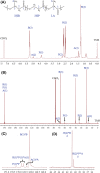Microbial synthesis of a novel terpolyester P(LA-co-3HB-co-3HP) from low-cost substrates
- PMID: 27860284
- PMCID: PMC5328817
- DOI: 10.1111/1751-7915.12453
Microbial synthesis of a novel terpolyester P(LA-co-3HB-co-3HP) from low-cost substrates
Abstract
Polylactide (PLA) is a bio-based plastic commonly synthesized by chemical catalytic reaction using lactic acid (LA) as a substrate. Here, novel LA-containing terpolyesters, namely, P[LA-co-3-hydroxybutyrate (3HB)-co-3-hydroxypropionate (3HP)], short as PLBP, were successfully synthesized for the first time by a recombinant Escherichia coli harbouring polyhydroxyalkanoate (PHA) synthase from Pseudomonas stutzeri (PhaC1Ps ) with 4-point mutations at E130D, S325T, S477G and Q481K, and 3-hydroxypropionyl-CoA (3HP-CoA) synthesis pathway from glycerol, 3-hydroxybutyryl-CoA (3HB-CoA) as well as lactyl-CoA (LA-CoA) pathways from glucose. Combining these pathways with the PHA synthase mutant phaC1Ps (E130D S325T S477G Q481K), the random terpolyester P(LA-co-3HB-co-3HP), or PLBP, was structurally confirmed by nuclear magnetic resonance to consist of 2 mol% LA, 90 mol% 3HB, and 8 mol% 3HP respectively. Remarkably, the PLBP terpolyester was produced from low-cost sustainable glycerol and glucose. Monomer ratios of PLBP could be regulated by ratios of glycerol to glucose. Other terpolyester thermal and mechanical properties can be manipulated by adjusting the monomer ratios. More PLBP applications are to be expected.
© 2016 The Authors. Microbial Biotechnology published by John Wiley & Sons Ltd and Society for Applied Microbiology.
Figures




References
-
- Brigham, C.J. , and Sinskey, A.J. (2012) Applications of polyhydroxyalkanoates in the medical industry. Int J Biotechnol Wellness Ind 1: 52.
-
- Chen, G.Q. (2009) A microbial polyhydroxyalkanoates (PHA) based bio‐ and materials industry. Chem Soc Rev 38: 2434–2446. - PubMed
-
- Chen, G.‐Q. , and Hajnal, I. (2015) The ‘PHAome’. Trend Biotechnol 33: 559–564. - PubMed
MeSH terms
Substances
LinkOut - more resources
Full Text Sources
Other Literature Sources
Molecular Biology Databases

